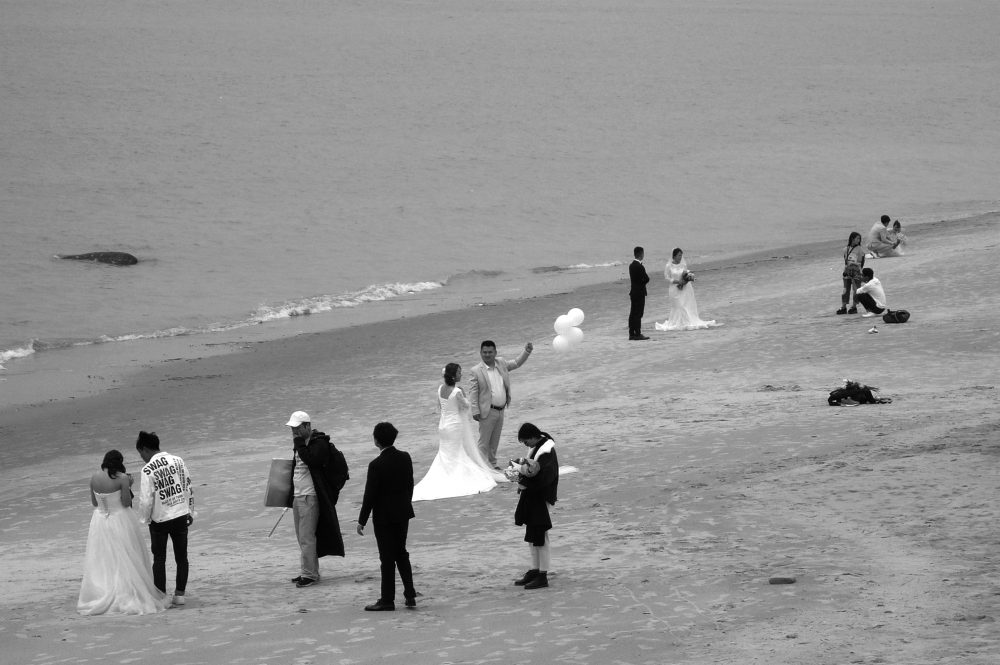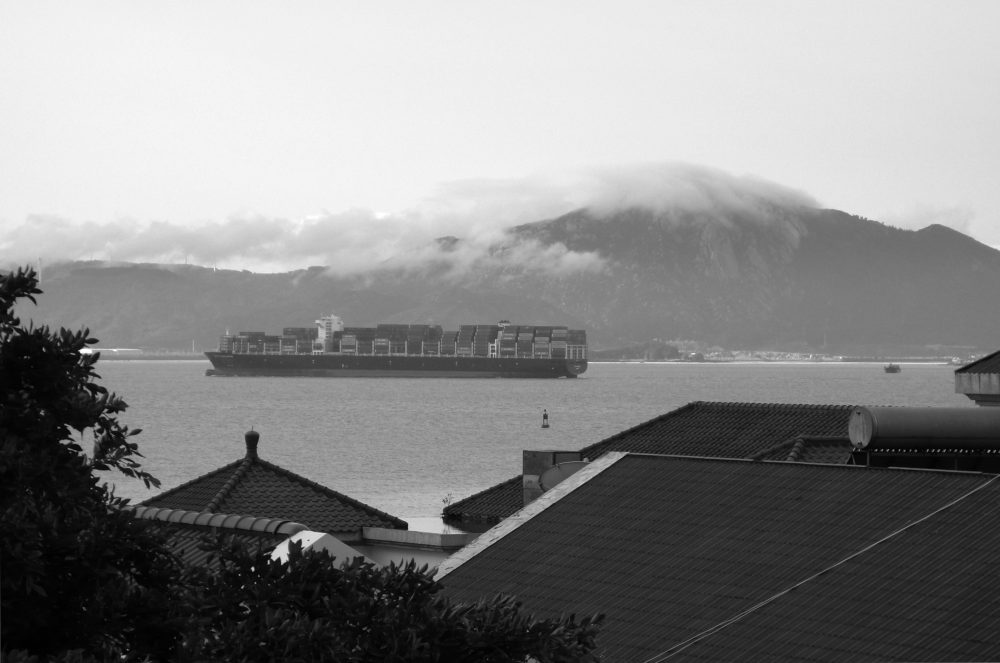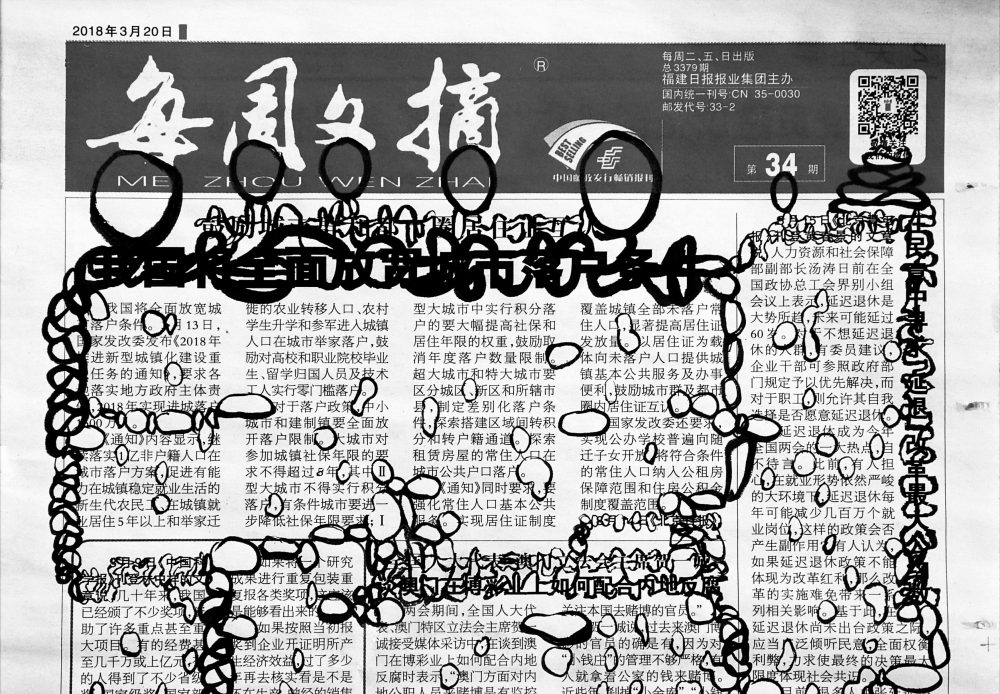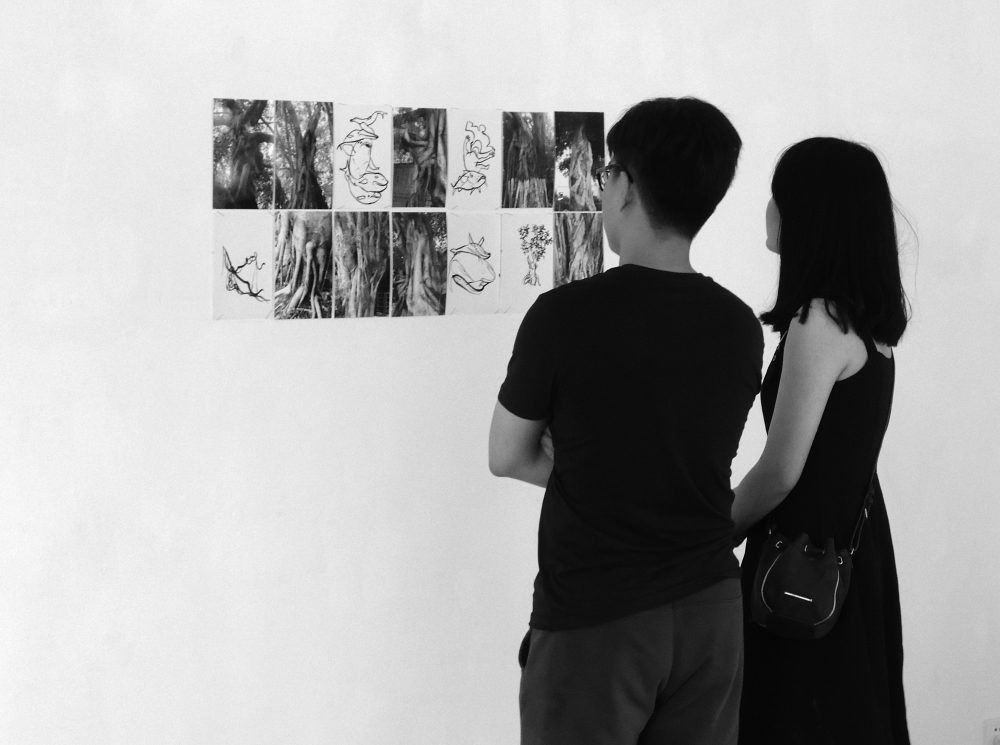Crash Course Xiamen
Tanja Smit is a visual artist. Her text works, drawings and paintings are an interaction between language and image, self-created rules and anarchy. From 1993 to 2009 she lived in Barcelona, where she further developed her artistic practice, among others by starting to convert her text works into music.

A number of Zen calligraphy workshops she attended there had a lasting influence. Since then she has worked a lot with ink and bamboo brush on paper. This has led to a growing interest in Eastern culture and a desire to get to know the cradle of the ink art, China, better. Last spring she spent three months in Xiamen.
The road is made by those who walk it. (Chinese proverb)
Xiamen is located on China's south coast, between Shanghai and Hong Kong, opposite Taiwan. About four million people live there. I have chosen this city because the CEAC (Chinese European Art Center) is located here, which was recommended to me by several people. Upon arrival, I found a disorganized CEAC: May Lee, the Chinese director, had suddenly been hospitalized a few days earlier. Ineke, the Dutch founder, is stepping in, together with artist friend Wei Na. After the first night in my new place I am offered to move to another apartment. It is left behind very badly by the previous user, but it is emptier and lighter, so better suited as a studio, and it has a view of the sea! I'll do it. Mr. Zhu, the IT guy from CEAC's network, assists with installing the Chinese sim card and the wifi. I'll be seeing him regularly, because the slow wifi system regularly breaks down and is not easy to start up again.
 The compound has fences and guards and my windows and balconies have silver bars, like some kind of luxury prison. Often it is foggy, but on clear days the view is breathtaking and very occasionally I can see islands and a neighbouring district. The light outside is warm and the glass in my windows is bright blue; a shock every time I open them.
The compound has fences and guards and my windows and balconies have silver bars, like some kind of luxury prison. Often it is foggy, but on clear days the view is breathtaking and very occasionally I can see islands and a neighbouring district. The light outside is warm and the glass in my windows is bright blue; a shock every time I open them.
The other two CEAC apartments are in neighboring flats, but most of the time only one is staffed; by Tara, a Dutch photographer and documentary filmmaker, and her family. She has been there for several months and generously shares information and contacts. In the first few days, CEAC gives me a short crash course in getting to know Xiamen: together, on various buses, we travel the routes to their office, the supermarket, the market and so on.
After a week a temporary resident moves into the third apartment: Ben, a young sculptor and video maker from Australia whom I meet at the screening of Tara's films at university. He spends most of his stay waiting for a contact with a metal workshop and we regularly stroll through the city together, exchanging thoughts and experiences.
After three weeks I note: "Not yet at work. Everything prepared: walls filled with putty, whitewashed, floors covered, materials brought in for small jobs. I make and print maps, buy food and missing furniture, walk through the city a lot, take pictures. Forgotten all my Chinese. Struggling with the map- and translation apps, which also crash all the time. Many images of animals in the cityscape. Busy with their symbolism. Everything is exotic here, exciting and new."
After a week a temporary resident moves into the third apartment: Ben, a young sculptor and video maker from Australia whom I meet at the screening of Tara's films at university.
Ben is leaving and Tara is busy. I miss contacts with other residents and with Chinese artists. The beach is beautiful and I often walk there, but it feels like a film set. Many couples and tourists are endlessly photographed and filmed, often under the direction of an extensive crew. Despite the warm weather nobody sits on the sand, only sometimes on the rocks, and I never see anyone swimming in the sea.
Gradually things start to fall into place. The city offers unexpected inspiration in the form of subtropical trees and rock formations that pop up everywhere between the high-rise buildings. Especially in the sexy and bearded rong shu or banyan trees, which consist largely of intertwined roots, I see all kinds of representations which I photograph.
 After a month I have to leave the country to extend my visa, which fortunately is easy, just up and down by boat to a small Taiwanese island off the coast. The next day I can finally start with my Chinese painting classes which had been postponed. They are very good. For a month I go to Chéng Hai Tāo three times a week to do calligraphy and Chinese painting. She shows me all kinds of things: different kinds of rice paper, how to glue them on a firmer surface, the meaning of some basic characters and how to write them, in what order and with what brushstrokes. How to mix colours and paint the different flowers, fish, birds, rocks. It is very intensive. One month is far too short to get the hang of it, but I make notes of everything, and sometimes photographs. The many rules do get in the way of my own work, inevitable of course, but I allow the confusion and interesting things arise.
After a month I have to leave the country to extend my visa, which fortunately is easy, just up and down by boat to a small Taiwanese island off the coast. The next day I can finally start with my Chinese painting classes which had been postponed. They are very good. For a month I go to Chéng Hai Tāo three times a week to do calligraphy and Chinese painting. She shows me all kinds of things: different kinds of rice paper, how to glue them on a firmer surface, the meaning of some basic characters and how to write them, in what order and with what brushstrokes. How to mix colours and paint the different flowers, fish, birds, rocks. It is very intensive. One month is far too short to get the hang of it, but I make notes of everything, and sometimes photographs. The many rules do get in the way of my own work, inevitable of course, but I allow the confusion and interesting things arise.
In the city I buy newspapers from which I make text works. I had looked forward to this in the Netherlands, but in the process I notice that it bothers me that I can only rely on the form of the text. The first two are exciting, but after that they become aesthetic images that lack content and depth. I'm going to leave this idea aside for the time being. Later on I'll work more on the layout and the photos, which do produce interesting images.
 A large part of life in Xiamen revolves around the enormous university. I get to know the social Lova through Tara. She introduces me to art student Muse who will assist me weekly with practical issues. When I ask her who her most inspiring teacher was she mentions Professor Li. At my request she calls him, and to my surprise we are invited to his home together: high up in one of the many new skyscrapers, where the interior suddenly looks like old China with wooden sliding doors, wainscoting, bamboo furniture and antique art objects. At the end of the evening he tells me that he will soon be making an excursion with students to a number of historical sites north of Xiamen. I can come along if I want. It leads to a great weekend a few weeks later when I'm on a trip with the professor and seven of his design master students in a minivan. We visit an old neighbouring town, with impressive historical buildings, a Taoist mountain, an island where a Buddhist cult has just taken place, a gigantic crafts mall where all my preconceptions about art and kitsch are put to the test, and much, much more. I also find some second hand books there, which I edit later. The best part is being with only the Chinese for two days, young open people who explain everything to me about what we see, but also about their culture and lives. Two students, Sucy and Yi, speak English well and translate. We keep in touch. They help me with the installation of my exhibition and more.
A large part of life in Xiamen revolves around the enormous university. I get to know the social Lova through Tara. She introduces me to art student Muse who will assist me weekly with practical issues. When I ask her who her most inspiring teacher was she mentions Professor Li. At my request she calls him, and to my surprise we are invited to his home together: high up in one of the many new skyscrapers, where the interior suddenly looks like old China with wooden sliding doors, wainscoting, bamboo furniture and antique art objects. At the end of the evening he tells me that he will soon be making an excursion with students to a number of historical sites north of Xiamen. I can come along if I want. It leads to a great weekend a few weeks later when I'm on a trip with the professor and seven of his design master students in a minivan. We visit an old neighbouring town, with impressive historical buildings, a Taoist mountain, an island where a Buddhist cult has just taken place, a gigantic crafts mall where all my preconceptions about art and kitsch are put to the test, and much, much more. I also find some second hand books there, which I edit later. The best part is being with only the Chinese for two days, young open people who explain everything to me about what we see, but also about their culture and lives. Two students, Sucy and Yi, speak English well and translate. We keep in touch. They help me with the installation of my exhibition and more.
The students produce surprisingly original and daring pieces of work; some overtly political.
My co-resident introduces me to the sub-head of the visual arts department at the university's arts faculty. She stops by and invites me to come give a lecture to the faculty about my work and a workshop to her first-year students. My lecture See the text, read the image takes place in the auditorium of the art faculty and is well received. The focus of the workshop is on newspapers and ink. The students produce surprisingly original and daring pieces of work; some openly political. The other people I get to know don't seem to care too much about state control either. There are things that are said in public one way and in private another. I experience a very intense and critical performance, but it takes place on the second floor, in an alternative space. It's a kind of collective psychoanalysis in which red scarves are cut through, among other things.
In the beautiful parks I make little ink drawings, starting with a bush, a rock, and ending in all kinds of things. After two months I need a new visa, for which I have to go all the way to Hong Kong this time, and stay there for at least three days. Also very interesting, but a big break, after which it takes time to get back to work properly.
 Two weeks before my departure, my exhibition opens at the CEAC. The title is Revenge of fish. The streets of Xiamen are full of live fish in full aquariums, buckets and basins, because they like it fresh. For the first time I feel empathy with them. They are so extra-terrestrially beautiful. Often displayed at eye level, it is impossible not to look into their eyes from time to time. They return in a number of drawings. With the chosen title, I also aim to illustrate how language evokes images. The text works and signified Chinese books are placed in self-manufactured display tables; on the walls hang large ink paintings on rice paper, drawings on Chinese newspapers and a series of smaller ink drawings, interspersed with photographs of banyan trees. The opening is festive and quite crowded, mostly by people from the university. I get to know CEAC's director May, who fortunately has recovered well.
Two weeks before my departure, my exhibition opens at the CEAC. The title is Revenge of fish. The streets of Xiamen are full of live fish in full aquariums, buckets and basins, because they like it fresh. For the first time I feel empathy with them. They are so extra-terrestrially beautiful. Often displayed at eye level, it is impossible not to look into their eyes from time to time. They return in a number of drawings. With the chosen title, I also aim to illustrate how language evokes images. The text works and signified Chinese books are placed in self-manufactured display tables; on the walls hang large ink paintings on rice paper, drawings on Chinese newspapers and a series of smaller ink drawings, interspersed with photographs of banyan trees. The opening is festive and quite crowded, mostly by people from the university. I get to know CEAC's director May, who fortunately has recovered well.
I have looked my eyes out, wondered and amazed, excited and elated.
Afterwards, together with a Dutch guest, I visit the famous island of Gülangyu and the round mud Tulou buildings in the interior. Both spectacular and interesting, but so touristy that we are glad to be back in Xiamen.
Then it's goodbye to the murmuring sea, the parks, the people I've come to know. The new work fits in my suitcase, advantage of paper. Newly acquired material goes by post. The stay was very intensive. I have stared my eyes out, wondered and amazed, excited and elated. It has resulted in friendships, inspiration and new insights; a soil for hopefully a next visit to China. It's exciting to see how this will translate into work in the near future.


